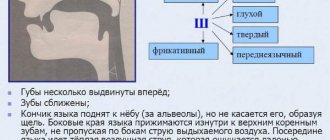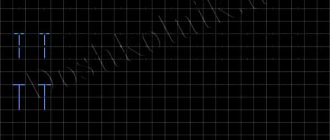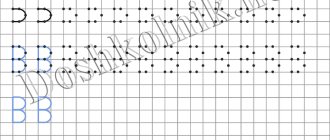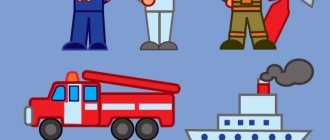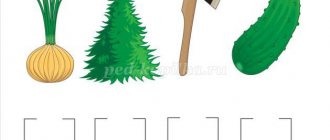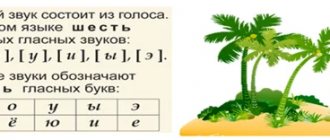Introducing the letter U
Lesson notes in 1st grade: introduction to the sound and letter “u”
Description of material:
I offer a lesson summary for 1st grade. The lesson material is aimed at getting to know the lowercase letter “u” and the sound [u] (reading and writing).
It is assumed that the character of the cartoon “The Engine from Romashkovo” will be present at the lesson: The engine; Brownie. Goal:
to introduce children to the sound [u] and the lowercase letter “u”.
General educational tasks and educational tasks:
- learn to pronounce the sound in accordance with the graphic image of the letter;
- develop the ability to isolate the sound [y] from a word; - teach writing the lowercase letter “u”; — develop communication skills; - cultivate a friendly attitude towards each other. Corrective tasks:
- to develop children's auditory perception, attention, articulatory apparatus;
- develop speech and thinking; — develop the analytical and synthetic sphere. Lesson form:
collective.
Equipment:
model of a steam locomotive; Brownie; poster with the Russian alphabet, subject pictures depicting a dove, snail, fishing rod, and the letter “u”.
Progress of the lesson
The sound of wheels sounds accompanied by rhythmic, not loud music.
Teacher:
Guys, today the Little Engine brought us an envelope with a new letter, but in order to open it, we must first answer the question.
Phonetic exercises Teacher:
How does a wolf howl in the forest?
Children:
Oooh
Teacher:
That's right!
Well, now I open the envelope and take out the letter that represents the sound that we all pronounced together. The sound [u] in writing is indicated by the letter “u”. Demonstration of the lowercase letter "u"
Teacher:
What do you think the letter “y” looks like?
If the children find it difficult, the teacher prompts them. Teacher:
U - knot. In any forest you will find the letter y. V. Stepanov
Teacher:
And now I suggest you find this letter in our Alphabet, which hangs on the wall near the board.
Children themselves or with a hint from the teacher find a letter in the alphabet. All children, including non-speaking children, take part in the search.
Teacher:
Now let’s try to write it.
Concentrate and watch and listen carefully. Analysis of the style of the lowercase letter "y". Teacher:
The letter “u” consists of 2 elements.
We begin to write the first element: from the top line we draw a straight line down, almost reaching the bottom line, we round it to the right and draw it upward to connect with the second element of the letter. Then, without lifting your hand, we begin to write down the written line with a loop at the bottom. This line must be straight and must intersect with the line on the bottom line of the working line. All explanations are accompanied by a demonstration on the board by the teacher. Next, the children write the letter “u” along the outline in their notebooks. Physical exercise. Teacher:
And now I suggest you rest a little.
We wrote, we wrote, Our fingers were tired. Now we’ll rest and start writing again. Teacher:
Look at what a beautiful picture the Little Engine brought with a picture of poultry.
The teacher takes out a picture of a duck from the Little Engine's carriage.
Teacher:
Did you find out what kind of bird this is?
Tell me, what is it called? If the children find it difficult to answer, the teacher suggests that it is a duck. Teacher:
What sound do you think the word duck begins with?
Children:
From the sound [u].
Teacher:
That's right!
Now let’s all say this sound together. Next, work is carried out in a similar way with object pictures that depict a fishing rod and a snail.
The teacher asks to name the sound that is pronounced at the beginning of these words.
Children pronounce the sound [u] several times in chorus. Teacher:
Well done!
Teacher:
Let's see, maybe the Engine brought something else?
It's a mystery. Let's try to guess? Children:
Yes.
Teacher:
Larger than a sparrow, you often meet me.
I fly with the flock, I pick up crumbs everywhere, I like to peck seeds and coo with my friend. Because of my peace-loving disposition I am called a bird of peace. If the children find it difficult to answer, the teacher takes out a subject picture with an image of a dove.
Teacher:
That's right, it's a dove, but do you think there is a sound in this word that we met today?
To do this, we will say this word again. Children, together with the teacher, pronounce the word “dove” slowly and drawlingly and find out that this sound is present in the word. Teacher:
Where do you think the sound [u] is hidden in this word, at the beginning or in the middle of the word?
Children:
In the middle of a word.
Teacher:
That's right, in this word the sound [y] is in the middle.
Well done! Next, the teacher and the children pronounce the sound [u] several times in chorus. Teacher:
Well, that’s all, it’s time for the Engine to return home, and you and I will see him off and invite him to visit us for the next lesson.
The sound of train wheels sounds. Teacher:
Look, Little Brownie has appeared. Well, why are you late for our lesson again! We'll have to tell him everything again. You are ready?
The lesson is summarized.
Reflection.
Article:
Topic: Sound U. Letter U. Goals: Correctional and educational:
- Introduce children to the sound u, the way of characterizing it based on articulation;
- Reinforce the concept of “vowel sound”, “word”;
- Introduce the letter U.
Correctional and developmental:
- Develop general, fine, facial and articulatory motor skills;
- Develop breathing and voice;
- Develop phonemic hearing, phonemic perception;
- Develop visual and figurative thinking;
- Develop the ability to form and use plural nouns.
Correctional and educational:
- To develop in children the ability to listen carefully to the teacher’s speech.
Equipment : subject pictures with the sound U at the beginning of the word (stress position): beehive, duck, ear, etc.; diagram for characterizing sounds, colored chips for designating sounds and drawing up diagrams, the letter U.
- Organizing time.
Game "Recognize by voice." -The speech therapist invites the children to stand in a circle. One of them goes out into the circle, closes his eyes and guesses by his voice who called him. 2. Main part.
- Mimic gymnastics “Oak”.
Oak of rain and wind. Bold facial expression. Not afraid at all. Who said that oak is Fear. Scared of catching a cold? After all, it remains green until late autumn. Joy. This means the oak is hardy, this means it is hardened. Pride.
- Articulation gymnastics
The teacher suggests performing a series of articulation exercises in front of the mirror: “Fence” - “Window” - “Bridge” - “Shovel” - “The shovel digs” - “Tasty jam”. The complex is repeated 4 times.
- Song "Musical voice" with movements.
The A-fingers are widely spaced; The O-fingers are gathered into a ring; The hand is clenched into a fist; I-thumb and little finger exposed; E-“soft” hands, palms forward.
- Getting to know the sound [ U ]
— The speech therapist shows a picture of a girl. This is Ulya. Let's say hello to her. - Children. Hello Ulya! - Speech therapist. Listen guys, what is the first sound in the name Ulya. The speech therapist pronounces the name, stretching out the first sound. The speech therapist places subject pictures: ears, iron, snail, etc. and for example an orange. — What sound do we hear at the beginning of each word? - Children. Oooh. - And in the word a-a-orange, what is the first sound, also y? - Children. No. The sound of
- Articulation of sound.
-Speech therapist. Look in the mirror and say the sound u. What position are your lips in? Where is the tongue? Are the teeth close together or closed? -Children. They are pulled out with a tube. Lies quietly in the bottom of the mouth. The teeth are close together.
- Characteristics of sound U.
-When we pronounce the sound U, does the stream of air encounter an obstacle on its way? -Children. No, the air stream comes out freely. -Speech therapist. We call this sound a vowel. -Children. Pronounce the sound U. Vowel. -The sound is U-vowel, we will denote it with a red chip. -Children show red chips and pronounce the sound U again.
- Isolation of sound [ у ] by ear
-The speech therapist pronounces vowel sounds: [a-o-u-i-a-e-u-a-i-o-u]. -Children, hearing the sound [u], clap their hands.
- Didactic ball game “One-many”
-Speech therapist: I will talk about 1 subject, and you will talk about many. Snail-snails, etc.
- Phys. Just a minute.
Children walk around the room. The speech therapist pronounces different vowel sounds. Children squat at the sound [u].
- Main part. Introducing the letter U.
-The speech therapist shows the letter U. Children, what does the letter U look like? -Children. The letter U looks like a snail's horns, a tree branch, a hare's ears, etc. -Speech therapist. Guys, what do you think, what is the difference between a sound and a letter? -Children. I hear the sound, I say! I see and write the letter! -Guys, how many elements does the letter y have? Let's write it in the air! -Children write a letter in the air. -Now let's make the letter U from sticks! -Children make the letter U from sticks. -Now open your printed notebooks and circle the letter U with a pencil, and what color will we use to circle the letter U? What color do we use to indicate the vowel sound U? -Children in red. Trace the letter U in a printed notebook. 4. Summary of the lesson. - Speech therapist. What is the first sound in the name “Ulya”? -Children. Sound U. -What sound is this? -Children. Vowel. -How did you guess? The air comes out freely and does not meet an obstacle. -What color chip will we use to denote it? -Red color. -The speech therapist evaluates the children’s activities.
